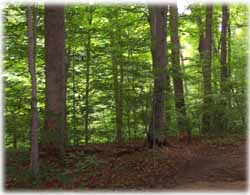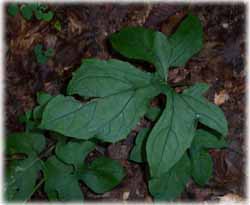Valley Stream Trail
Cleveland MetroparksBrecksville Reservation
Trail Location
Brecksville, Ohio (Cuyahoga County)
Park at the Brecksville nature Center on Chippewa Creek Drive. Chippewa Creek Drive can be accessed from State Route 82 or Riverview Road in Brecksville, Ohio.
Trail Summary
Length: 1/2 mile.
Duration: 40 Minutes
Surface: Gravel/natural.
Type: Loop.
Difficulty: easy
Accessibility: no

The forests around the Valley Stream Trail are a mix of older white oaks and younger Maples and beech.
Trail Description
The Valley Stream Trail is a loop trail which meanders trhough the oak woods of Brecksville Reservation. Begin hiking at the Brecksville Nature Center. Proceeding clockwise, the trail quickly descends into a peaceful stream valley. After descending the stairs, you will cross the stream. The water flows from the forests above this small valley into this creek, which converges with Chippewa Creek, and thence into the Cuyahoga River just south of the Station Road Bridge.In mid-summer, you will notice small clusters of tiny white flowers seemingly springing from the dead leaves of last fall. The flowers are probably those of Ramps, or Leeks. The wide lily-like leaves of the leeks are green in early spring, but then quickly die back. The flowers spring up after the green leaves are gone. In late summer, the remains of these flowers will be tan or brownish, with perfectly spherical, hard black seeds nestled in the center of each. If you dare to crack one of these seeds between your teeth as you hike, you will be rewarded with a taste somewhat akin to onion, but with a tinge of pizza aftertaste. Don't take all of the seeds, however, as overcollecting the seeds may cause the population of these plants to dwindle.

Lion's Paw, a typical plant of the forest floor in northeast Ohio.
As you hike along through these woods, you will notice that the trail gradually rises. The forest is a mixture of white and red oaks, with a large component of younger beeches and maples. This is an opportunity to see clear evidence of natural succession. Oaks are shade intolerant for the most part. That means that they like to grow in lots of light, and conversely, they do not grow well in shade. So you generally see oaks regenerate in either a recent clearcut, a burned out area, or a large gap that allows in ample light for a long period of time. Beeches and maples on the other hand, will grow under dense shade. They sprout and grow into the midlevel of the forest, or into the sub-canopy, then wait there, for perhaps several hundred years, growing slowly and biding their time. They grow fine in the shade of existing forests, whether it is composed of oak, beech, maple, or other species. Then, when something kills the dominant overstory trees, whether insects, wind, lightening, or old age, these shade tolerant trees spring into action.
In the space of a few years they will fill the gap left by the former dominant tree. In a beech maple forest, it is usually the beeches and maples that dominate the seedling and sapling layers. So, guess what replaces the beeches and maples when a large tree leaves a gap in the canopy. You guessed it. Beeches and maples for the most part. Tulip, cucumber magnolia, ash, cherry and a number of others may also grow well in these areas, but generally, it will be beeches and maples, unless there is a really large gap, such as that created by a tornado.
Take a look around. Try to decide what will replace the larger trees if they die. I bet you will find that after the oaks die out, this forest will become a beech maple forest.
As you come out of the forest, you will notice a small stone patio around a small monument to Harriet Keeler, a naturalist, conservationist and author. Beyond the memorial, you will walk through a prairie, planted with native prairie plants and managed by Cleveland Metroparks by burning to keep the forest plants from recolonizing. A small observation deck here has some nice descriptions of ecology, as well as some pictures to help you identify the prairie plants. From here it is a short walk back to the Brecksville Nature Center.
Nearby Trails
Scenic Overlook Trail
Chippewa Creek Parkway All Purpose Trail
Valley Parkway All Purpose Trail
Ohio and Erie Canal Towpath Trail (CVNP Section)
Buckeye Trail
